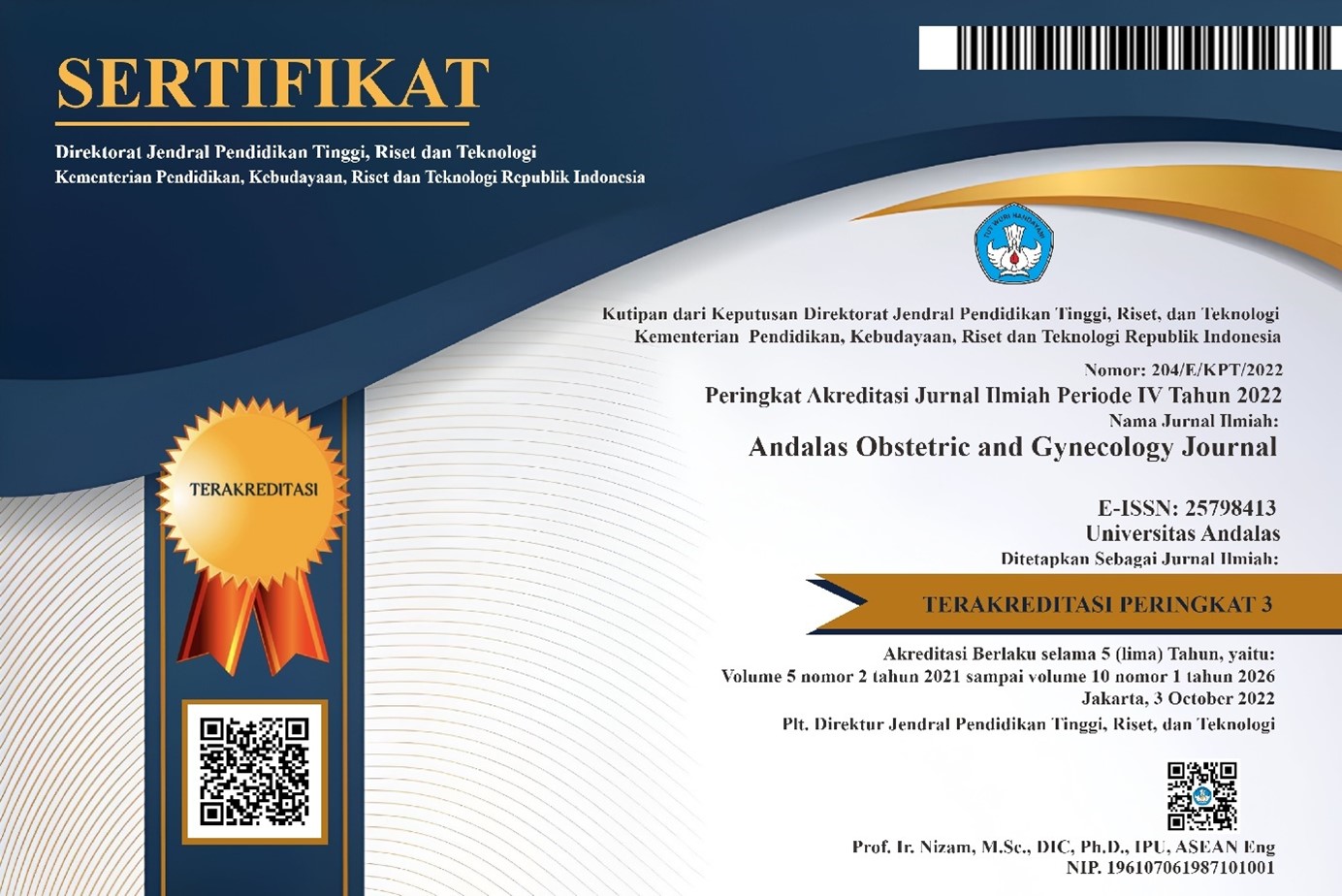Differences of Fibronectin Levels in First Trimester Normal Pregnency and Miscarriage
DOI:
https://doi.org/10.25077/aoj.8.1.648-653.2024Keywords:
Miscarriage, Fibronectin, Normal pregnancy, First trimesterAbstract
Introduction: Miscarriage is a reflection of the low quality of health in pregnant women. The incidence of miscarriage in the world accounts for 23 million (15%) of the 130 million births per year and up to 80% of miscarriages occur in the first trimester of pregnancy. Miscarriage will affect a woman's social, physical, and psychological. The complexity of the negative impact of miscarriage makes it necessary to pay special attention. Biomarker examination is needed to more accurately identify pregnancies at risk of miscarriage before the appearance of clinical symptoms. The use of fetal fibronectin (fFN) levels have been used as a marker of unexpected labor and as evidence of premature rupture of the fetal membranes. Normally fFN can be detected in cervical and vaginal secretions at <20 weeks gestation. The presence of fFN at >22 weeks gestation indicates disruption of the uteroplacental surface. Therefore, if screening for fibronectin levels using the Enzyme-Linked Immunosorbent Assay (ELISA) test can be carried out in the first trimester of pregnancy, there is a high possibility that miscarriage can be prevented.
Method: The type of research is analytical observational research with a cross-sectional research design. The stored samples were examined for fibronectin levels using the ELISA test, which included 21 blood serum samples from normal pregnancy patients in the first trimester and 21 miscarriage samples.
Results: The results of the ELISA test produced an average first-trimester normal pregnancy fibronectin level of 118.8 ± 18.4 ng/mL while the miscarriage fibronectin level was 208.2 ± 152.0 ng/mL. Data analysis using the Mann-Whitney test obtained a p-value = 0.138, which means there was no significant difference in fibronectin levels between normal pregnancy in the first trimester and miscarriage.
Conclusion: This study concludes that fibronectin levels are not specific biomarkers in detecting miscarriage in the first trimester of pregnancy.
References
Kementerian Kesehatan RI. Pedoman nasional asuhan pasca keguguran yang komprehensif. Kementerian Kesehatan Republik Indonesia. 2020. 11–15 p.
Mehdi Moradinazar M x, Rostami R, Armaghan N, Shakiba M, Rai A, Abbasi Azizi S, et al. Epidemiological features of spontaneous miscarriage in the north africa and the middle east from 1990 to 2019: results from the global burden of disease study 2019. J Fam Reprod Heal. 2022;16(3):183–91.
Nisa PK, Farida K. Karakteristik ibu berhubungan dengan kejadian abortus. J Kebidanan Indones. 2023;14(2):90–9.
Dugas C, Valori H S. Miscarriage. Treasure Island: StatPearls Publishing; 2023. 3–5 p.
Gan J, Gu T, Yang H, Ao Z, Cai G, Hong L, et al. Non-coding rnas regulate spontaneous miscarriage: a global network and system perspective. Int J Mol Sci. 2022;23(8):1–2.
Wahyuni IS, Kartini F, Raden A. Dampak kejadian pasca abortus spontan pada ibu hamil. J Kesehat. 2022;7(2):353–60.
Mohamed H, Alhialy F, Naif MM, Rashid SA, Alhialy HMF, Naif MM, et al. Ultrasound golden roles in early pregnancy failure and miscarriage diagnosis. 2021;44(05):2057–67.
Hussain AH, Abdalla YA, Abdalla RB, Abdalla DS, Baiz KA, Hamarahim BA, et al. The use of fetal fibronectin and vaginal ph as new laboratory markers for detection of preterm delivery in iraq. Pakistan J Med Heal Sci. 2020;14(2):793–5.
Mohammed H., M.A M, I.i S, M.M AA. Fetal fibronectin: A new tool for the prediction of successful induction of labor. Benha J Appl Sci. 2021;6(2):101–5.
Hardy K, Hardy PJ. 1(st) trimester miscarriage: four decades of study. Transl Pediatr. 2015;4(2):189–200.
Preisler J, Kopeika J, Ismail L, Vathanan V, Farren J, Abdallah Y, et al. Defining safe criteria to diagnose miscarriage: Prospective observational multicentre study. BMJ. 2015;351.
Speziale P, Arciola CR, Pietrocola G. Fibronectin and its role in human infective diseases. Cells. 2019;8(12).
Berghella V, Saccone G. Fetal fibronectin testing for reducing the risk of preterm birth. Cochrane Database Syst Rev. 2019;(7).
Volgsten H, Jansson C, Darj E, Stavreus-Evers A. Women’s experiences of miscarriage related to diagnosis, duration, and type of treatment. Acta Obstet Gynecol Scand. 2018;97(12):1491–8.
Zhang S, Fu S, Liu Y, Chen L, Zhu L, Tan J, et al. Predictive value of fetal fibronectin on the embryonic loss of patients with recurrent spontaneous miscarriage in early pregnancy. Clin Exp Obstet Gynecol. 2014;41(4):380–3.
Nowacek GE, Meyer WR, McMahon MJ, Thorp JR, Wells SR. Diagnostic value of cervical fetal fibronectin in detecting extrauterine pregnancy. Fertil Steril. 1999;72(2):302–4.
Downloads
Published
Issue
Section
License
Copyright (c) 2024 Maisarah Fadhilah, Bobby Indra Utama, Tofrizal Tofrizal

This work is licensed under a Creative Commons Attribution 4.0 International License.
Copyright
Authors who publish with this journal agree to the following terms:
- Authors retain the copyright of published articles and grant the journal right of first publication with the work simultaneously licensed under a Creative Commons Attribution 4.0 International License that allows others to share the work with an acknowledgment of the work's authorship and initial publication in this journal.
- Authors are able to enter into separate, additional contractual arrangements for the non-exclusive distribution of the journal's published version of the work (e.g., post it to an institutional repository or publish it in a book), with an acknowledgment of its initial publication in this journal.
- Authors are permitted and encouraged to post their work online (e.g., in institutional repositories or on their website) prior to and during the submission process, as it can lead to productive exchanges, as well as earlier and greater citation of published work (See The Effect of Open Access).
License:
Andalas Obstetrics and Gynecology Journal (AOJ) is published under the terms of the Creative Commons Attribution 4.0 International License. This license permits anyone to copy and redistribute this material in any form or format, compose, modify, and make derivatives of this material for any purpose, including commercial purposes, as long as they credit the author for the original work.







